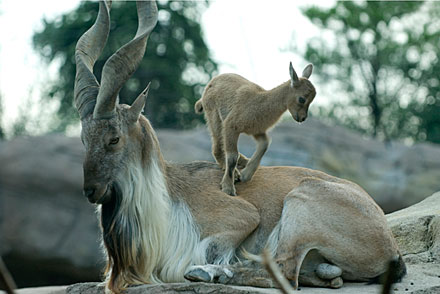
The markhor is making a remarkable comeback in Pakistan. (photo: Grahm Jones/Columbus Zoo)
Community surveys led by the Wildlife Conservation Society have revealed that markhor populations in northern Pakistan’s Kargah region in Gilgit-Baltistan have increased from a low of approximately 40-50 individuals in 1991 to roughly 300 this year. The total markhor population in Gilgit-Baltistan may now be as high as 1,500 animals, a dramatic increase since the last government estimate of less than 1,000 in 1999.
Known for their spectacular corkscrew horns that can reach nearly five feet in length, markhors are an important prey species for large carnivores such as wolves and snow leopards. They have been listed as Endangered by IUCN since 1994, with a 2008 global population estimate of less than 2,500 animals across five countries: Pakistan, Afghanistan, Tajikistan, Uzbekistan, and India. They are threatened by illegal hunting, habitat destruction, and competition from domestic goats and sheep.
They are also susceptible to disease such as a pneumonia outbreak which occurred in September and October of 2010, believed to have killed at least 65 markhors—as much as 20 percent of the population remaining in the country. Researchers believe the wild goats may have contracted the disease from domestic goats. The outbreak emphasizes the need for continuous disease surveillance in domestic animals that have contact with valuable wildlife resources.
Much of the rebound is credited to the efforts of conservation committees and wildlife rangers throughout Gilgit-Baltistan over the last 15 years that have been monitoring and managing the region’s wildlife and forests and clamping down on Illegal hunting and logging. Their protection extends to safeguarding markhor as they travel across steep-sided mountains into different areas.
Sourced from materials provided by Wildlife Conservation Society.